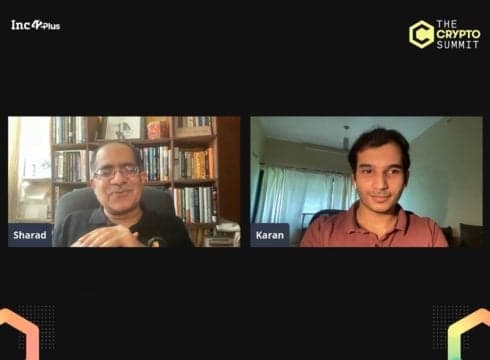Using Project Sakhi, crypto can be channelised from across the world to provide loans to Indian MSMEs, says Sharad Sharma, cofounder, iSPIRT at The Crypto Summit
To regulate crypto, there’s a need for a techno-legal regulation, similar to what the RBI did in the case of account aggregators
IFSC, GIFT Gujarat can act as a unified regulator in this context, thinks Sharma
Inc42 Daily Brief
Stay Ahead With Daily News & Analysis on India’s Tech & Startup Economy
India’s volunteer-based technology think tank iSPIRT Foundation is working on crypto as another building block for India Stack. Speaking on day 1 of The Crypto Summit, India’s largest crypto and blockchain summit, Sharad Sharma, cofounder of iSPIRT Foundation presented how crypto can be incorporated into India Stack APIs and will pool the immensely required credit system to the Indian MSME ecosystem.
With Account Aggregator and Open Credit Enablement Network (OCEN), Sharma averred that as average loan amounts going as low as INR 238, there will be a massive increment in the loan demands in the near future and a crypto-based DAP (Digital Asset Pool) Fund can fulfil this.
‘The Existing Building Blocks Ain’t Enough’
Taking the famous Rajni example, a vegetable seller who lives in the slums of Bhopal and has 3 children, Sharma said that iSPIRT has been working on democratising credit for the likes of Rajni who borrows INR 250- INR 300 every morning and then pays it in the evening with some interest amount.
“In the last six-seven years, we have made considerable progress, yet it will take another 18 months to serve the likes of Rajni…There is one building block that is still pending, it’s called the public credit registry,” Sharma said.
However, among the key issues that India Stack has ably resolved for MSMEs are fast access to information that was otherwise not available, lowering the cost of lending and bringing transparency and multiparty protocols. And, that’s why big lenders with 100s of Cr of turnover are now lending small amounts, as small as INR 238.
“The important thing that lenders have recognised is that they can make money on that loan, which means that the friction of giving a loan and recovering the loan is very low. Otherwise, nobody will give an INR 238 loan because it involves e-KYC cost, the cost of sending INR 238 to the person, the cost of recovering that INR 238 and monitoring and making sure all that happens. If this was not fully digital and low cost, these small value loans would not have been possible at all. So, this system is working.”
Announcing Project Sakhi ecosystem which has incorporated crypto as an essential building block, Sharma said that with OCEN, the loan volume will rise to the extent that we will run short of capital to feed this.
This is where comes the DAP Fund that aims to utilise the Liquidity Pool (LPs) to fund these borrowers.
Karan Desai, a volunteer at iSPIRT said, the MSME credit opportunity has been estimated to be INR 20 to 25 Tn i.e. $300 Bn. That’s huge. As only 10% of the credit finance comes from the banks or NBFCs, rest is attributed to the informal sector where interest rates vary from 18-35%.
This opportunity is actually a big source that is moving away from the existing types of lending — value chain finance. Our banks and financial institutions have been mostly conservative when it comes to extending a loan. As does the electricity get a car’s wheels running, we need a catalyst like crypto.
“With crypto, we are trying to find solutions to real-world problems,” Desai said.
How DAP Fund Would Work
An open-source and volunteer-based iSPIRT’s Project Sakhi is working on how to push capital from the crypto market that is around $2.2 Tn into the Indian MSME market. iSPIRT is trying to infuse the DAP Fund which will source funding in crypto and make avail loans to MSMEs in INR/USD.
The DAP Fund will channelise the locked liquidity tokens and hence will be on-chain receiving funds while off-chain for its disbursal. According to Sharma, GIFT Gujarat’s IFSC can be a possible regulator to enable this ecosystem.
Need A Techno Policy For Crypto
Speaking about the challenges while integrating crypto as another building block, Sharma averred that there are mainly two key challenges:
- Technology
- Regulation
While India has enough talent to meet the technology challenges, policy challenges are a little trickier. There requires an orbital shift to meet this challenge.
“The regulation has to make a shift from pure regulation, that is regulators issuing guidelines to techno-legal regulation when there is a standard and then there are policy rules. India has done that in the case of account aggregators (AA). So, going forward, we need a techno-legal framework for crypto,” said Sharma.
{{#name}}{{name}}{{/name}}{{^name}}-{{/name}}
{{#description}}{{description}}...{{/description}}{{^description}}-{{/description}}
Note: We at Inc42 take our ethics very seriously. More information about it can be found here.


